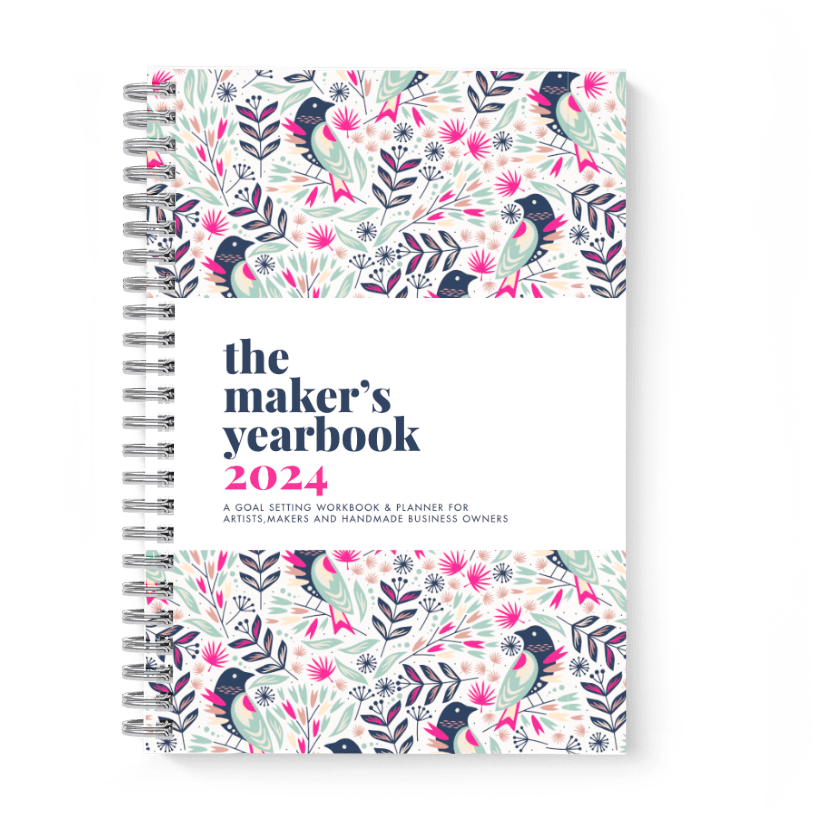There are so many challenges involved in running a handmade business and for many of them, we can’t really see them coming or know what kind of impact they’ll have on our business.
Banking crises, Global Financial Meltdown, Brexit, Inflation, Consumer Confidence.
There are many things that are just out of our hands, which is why it is so important to handle the challenges that we can foresee.
The challenges that come from miscommunication or no communication. The challenges that come from different expectations of how things will work, or different definitions of certain terms.
These are things that are definitely within our control and the way that we can protect ourselves from these kinds of challenges is by having a solid set of terms and conditions.
Writing your terms and conditions could very well be something you’ve put off for a long time.
It’s not sexy and it’s not exciting, but it’s just as important as all of the other stuff.
And not just for your protection from legal and financial issues, but also for protection from headaches and frustrations that can leave you discouraged and taken advantage of.
Even if your business is brand new and you don’t yet have many customers or many retailers selling your products it’s important to think about how things might work in the future, to save yourself headaches later down the line.
I’m going to take a moment here to say that I am not qualified to offer any legal advice and I won’t be doing that in this post. We’ll be focusing on some common issues that makers face that you might want to address in your terms and conditions for wholesale and sale or return retailers.
We won’t look at terms and conditions for your website and direct sales to your customers as the contents of these will often be dictated by the consumer law of the country you are trading in. You’ll need to familiarise yourself with the laws involved in selling to consumers and make sure that your terms and conditions are in compliance with those laws. If you’re unsure, make sure to seek out advice from a legal professional or your local trading standards office.
One of the reasons you might have put off writing your terms and conditions for your stockists is that you simply don’t know how to get started and you’re worried that you might look unprofessional if you’re not familiar with industry standards. But, for the most part, terms and conditions that show you have put a lot of thought into how the relationship will work and what is fair for both sides will usually make you look more professional, rather than less, even if you have something in there which the retailer is not willing to accept. They will tell you and this is the starting point for your negotiation.
Your terms and conditions will simply set out your expectations of how the relationship will function and might actually make the retailer feel more comfortable in working with you.
So let’s look at some issues that you might want to address in your terms and conditions. As selling wholesale and selling via sale or return work quite differently, it may be best to have separate terms and conditions for each one and we’ll look at each separately.
First let’s look at wholesale
1. Exclusivity
This is an area where there are a lot of differences in expectations and so it’s really important to set out under what circumstances you will give a retailer exclusivity in their local area, and what that means.
Some things to consider:
Will you give exclusivity in just their local area? In their town? In their city? Will you agree not to stock any other retailer within a certain distance of their store? Make sure you consider this carefully and you may have to use some discretion. Giving someone 10 miles of exclusivity may work fine in a rural area but you wouldn’t want to offer that in a city because that would make most of the shops in the city unavailable to you.
How long will you guarantee exclusivity for? It’s generally a good idea to put a time limit on any agreement that limits where and how you can sell. You can always review the arrangement and extend it, but this gives you an opportunity to get out of the exclusivity agreement if the opportunity hasn’t turned out as well as you would have hoped.
Will you require a minimum level of annual sales in order to guarantee exclusivity?
When you guarantee exclusivity to one retailer, you are effectively agreeing to limit any further income you could receive from any other shops in that particular area so you would definitely want to make sure that it was worth your while to do so.
Otherwise it is possible that you could find yourself in a situation where you have guaranteed exclusivity to a very small retailer who has ordered from you once and you are then approached by a much larger retailer and you either have to say no to them or break your promise to your existing retailer.
Neither one of these is a path to having good, professional relationships with your stockists so it’s better to be very clear from the beginning about your expectations. You can always choose to waive these requirements on a case by case basis, but it’s good if your terms provide a starting point for the discussion.
2. Payment Terms
A very important area to set out expectations.
When do you expect to get paid?
Will you require payment in advance for all orders placed or will you extend credit of 30 days?
What will happen if invoices are not paid in a timely manner?
What payment methods do you accept? Are there any that you don’t accept?
Will payment terms be reviewed if the credit period is being exceeded on a regular basis? Will you accept payments in foreign currencies?
Again, you can review these terms on a case by case basis. Many retailers will have their own requirements when it comes to making payments and you can either accept those, reject them or try to negotiate, but it’s important to have your own terms and conditions for times when this is not the case.
3. Cancellations
What will happen if a retailer places an order then later wants to cancel it?
What will be the cutoff point for order cancellations?
Will you allow retailers to return unwanted items after delivery? Will you charge the retailer a restocking fee for these?
Will you offer refunds or just exchanges? What kind of condition do these items need to be in, in order to get a refund?
What about products that the retailer hasn’t sold and would like to exchange later down the line? Will you allow this? What condition will they need to be in? What can they be exchanged for? Will you allow exchanges on their own or only as part of a new order?
If your products use expensive raw materials, how will you protect yourself from losses if the retailer decides to cancel their order after you have started making but before the items are despatched?
Will you require a deposit? Will this be refundable under any circumstances?
4. Order Fulfilment
As making times can vary so widely from one handmade maker to another, it’s really important that you are clear with the retailer about when they can expect delivery of their order. Make sure that you give yourself adequate time too so that you don’t get overwhelmed. Remember it’s always better to under promise and over deliver!
You can always provide rough estimates so that the retailer knows if we are talking about days, weeks or even months, and then provide a more accurate despatch estimate once the order is placed.
5. Delivery
What are your delivery charges?
Do you offer free shipping and, if so, what is the minimum order value to be eligible for this?
How will you ship goods to the customer? Courier? Regular postal service? Something else?
What should the customer do if the goods do not arrive?
Who is responsible for customs charges that may be applied?
Now let’s consider Sale or Return.
1. Condition of Products
Who is responsible for theft, damage or breakages?
Who is responsible for insuring the work while it is at the shop or gallery?
Will you permit the shop or gallery to remove items from packaging for display or will you provide samples for this purpose?
Do you have expectations around cleaning of jewellery pieces?
2. Agreement Period
Will this be a rolling agreement or will there be a fixed term during which you will offer your products on Sale or Return, perhaps as a way for the retailer to test them out, or as part of a fixed term exhibition?
What will happen at the end of this period if the retailer wants to keep selling your work? What will happen if they don’t?
3. Payment Terms
Again, this is extremely important. Many Sale or Return shops galleries will be making payments to tens or even hundreds of makers, so they may already have systems in place that they adhere to, but you need to know what these systems are. Your terms and conditions can help you to set out your expectations and see to what extent these match up with what the shop or gallery is offering.
Payout terms vary dramatically from one shop or gallery to another and their level of organisation in this area can be a really good clue as to how they run their business overall. The most successful shops and galleries will usually have very solid streamlined systems for getting the payments done, so that they can spend their time selling more products, which is exactly what you want to see.
A common practice for ongoing sale or return relationships is to make payment by the end of the month, for sales made in the previous month. For fixed term exhibitions, it is common to make payment within one month of the end of the exhibition for sales made during the entire exhibition period.
You should also set out your expectations regarding documentation of products sold. Will the gallery tell you what it has sold or will you simply receive a payment? Will they tell you which particular designs have sold or just the product type? In the case of Limited Edition prints, will they tell you the print number?
Don’t be uncomfortable or embarrassed asking for a clear explanation of when and how payments will be made. It’s part of your responsibility as the owner of your business to understand the agreements that you’re entering into.
4. Postage Costs
Who will pay postage costs to the gallery?
Who will pay postage costs for any products that need to be returned to you? Will this depend on who wants the products returned?
Do the products need to be returned by a particular postage method? Who will insure the goods while they are en route?
5. Selling on your behalf
There are many different interpretations of sale or return so, again, it’s best to be absolutely clear about your expectations.
For me, Sale or Return always means that the retailer is acting as a sales agent for the artist or maker, and receives a commission as payment for doing so, but you may encounter retailers with different interpretations.
When the retailer is acting as an agent, the work belongs to the maker and the maker sets the price and the selling conditions. This means that you need to set out the retail price you expect the items to be sold for and whether the retailer has permission to discount that price and under what circumstances.
You also need to be clear about whether the delivery note you send with shipments includes the retail price, the artist’s price or both. It’s usually best to include both so that there is no confusion.
You may also want to include your expectations around display and storage of your work. Do you expect that all of your work will be on display all of the time? Or are you happy for the gallery or shop to perhaps keep some pieces in storage and rotate them into the display to save you from having to bring in new stock so often?
What about if you have some seasonal products? Are you happy for the retailer to discount them to make sure they sell? At what point do you want that to happen? Or would you prefer to have them returned to you?
6. Customer Orders
Occasionally a customer will approach the retailer and ask if they can order something that the retailer doesn’t currently have in stock. This might be something they had previously, but has now sold, or it might be an item in a different colour, size or finish. In cases like this you need to set out what will happen.
Will the retailer take payment in advance or will they contact the customer once they have received the ordered items? What if the customer no longer wants the item? Who will pay for delivery on these orders? Will the item be delivered to the retailer or direct to the customer? What will the timeframe be?
This might seem like a lot to think about but try not to get overwhelmed. Just remember that in relationships with your retailers, your terms and conditions (and theirs if they have them) are only the starting point for a negotiation. It’s like putting all of your cards on the table and saying “This is what you can expect from me and this is what I expect from you.”
Sometimes this might lead to a situation where you realise that you’re not able to work with a certain retailer but I always firmly believe that the best time to find out that a retailer is unable to fulfil your expectations is BEFORE you start working with them.
It’s also good practice to review your experiences with your stockists every few months and think about any situations that made you upset or uncomfortable or that caused you financial difficulties. Add to your terms and conditions so that in future you can spot these issues before they arise.








